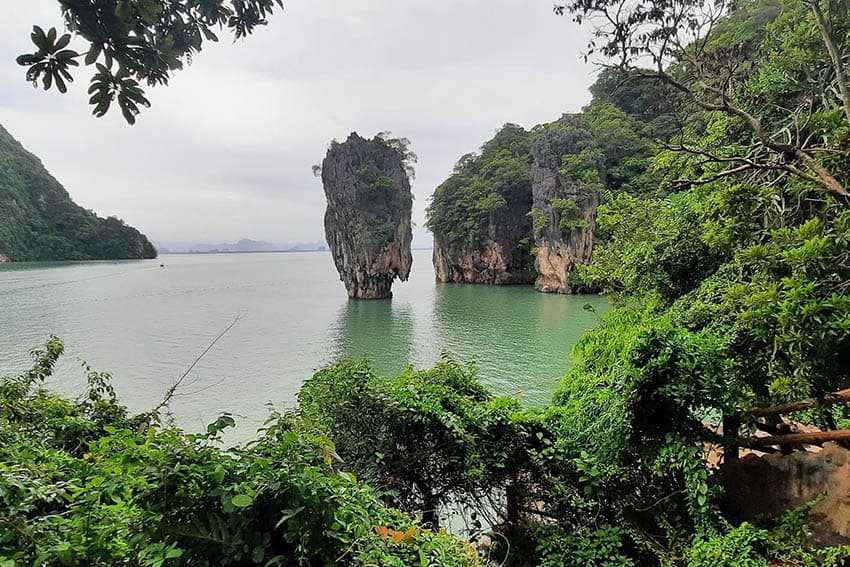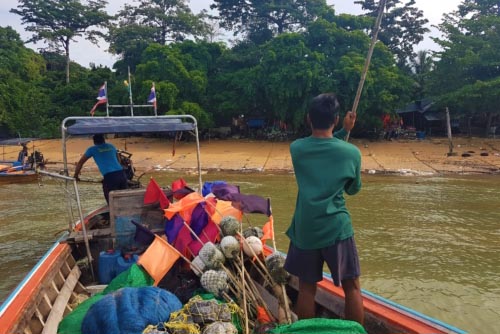Holiday Recreation: Sea Kayaking In Thailand
By Elaine Jane Sirivong na Ayuthaya
A Little History of the Kayak

The Eskimos were the first to invent kayaks primarily for hunting and transport. Eventually they were to carry them as far south as Panama . These kayaks made out of seal bones and skins had nothing to prevent them from slowly rotting away over the years; hence the reason why there aren’t many remains of traditional kayaks to be seen these days.
Modern-day kayaking became popular in the ’60s mainly as a white water sport. Sea kayaking picked up in the ’70s as a recreational activity and was soon embraced by the environmental movement. Today, many people are into it for the physical challenge and to bring them closer to the environment.
A Modern Day Kayaker’s Paradise
Southern Thailand is a sea kayaker’s paradise and the Andaman Sea offers tremendous opportunities for both first-time paddlers and the serious marine explorer. Here, unique and remote limestone islands sprout from the sea, several reaching heights over a thousand feet with some shaped like eerie-looking animals. Many of these isolated islands feature dramatic sea caves and sheltered, pristine beaches.
Phang Nga Bay, which separates Phuket from the mainland, is the site of a rare geological process that eroded the centers out of the soft skeletons of ancient volcanoes, creating vertical chimneys that collected fresh rainwater and protected the fragile ecosystem from the wind, sea and blistering tropical sun.
Today, as you enter these natural rooms, called hongs in Thai, you will discover a world of serenity and truly unforgettable experience.The islands are host to many species of exotic wildlife including monkeys, sea eagles, egrets and monitor lizards. In addition, some of the island caves are used as nesting sites by flocks of thousands of swallows. The nests command a very high price in the market as they make up the ingredients for bird’s nest soup and have become a valuable source of income for the local fishermen.
Entering a Hidden World
For any given day, even at the beginning of the monsoon season, the atmosphere is a blend of beautiful sunny weather and breathtaking panoramic vistas. Going with a reputable kayaking company like Sea Canoe will sail you up from Phuket to Phang Nga Bay on a chartered boat. John “Caveman” Gray who introduced the sport to Thailand in 1989 founded Sea Canoe, the venture that popularized canoeing with a kayak paddle in 1983.

Once in Phang Nga Bay, either you paddle alone or paddle with a guide in a yellow inflated kayak called Sea Explorer. Your recreational director will always know when the tide is at the right level to enter the hongs for the awaited discovery. The experience of entering through a narrow passage lined with coral and seashells is sometimes scary. You lie down flat on your back wondering if you would fit through the small opening without rubbing your nose on the rough stone roof of the dark corridors.
In an instant, you are inside a new world where the sound of silence abound interrupted only by the chirping of cicadas. Rare and very tall trees towering up to the sky along with lush tropical vegetation come alive inside the hongs, a paradise beyond your wildest dreams.
The journey from one room to the next must be carefully timed, since the ‘window’ into the rooms is only passable at certain times of the tide table. Come too soon and you’ll find your window under water, come too late and you’ll be trapped inside by the receding waters. The floor of the caverns is too irregular to permit walking out.
Waves, Rocks, and a Couple Armed With an AK47
It isn’t always smooth paddling on a kayaking trip. You may encounter strong currents and unexpected shallow rocky outcrops; luckily if you are sitting on a Sea Explorer, these are extra tough and stable. Their shallow inflatable skin sits atop a roto-moulded plastic kayak body giving the adventurous explorer equal doses of safety and comfort.
Kayaking is the name of the game so as you paddle for sometime, you get accustomed to the waves and your arms become fully in tune with the motion of the paddle and you want to explore farther. One of the special attractions, which are not included in a Sea Canoe expedition, is visiting one of the biggest limestone caves that could have housed a cathedral. Indeed it is a cathedral-of swallows guarded by a man and his wife. Their only weapon is a Chinese AK47 for scaring un-welcomed visitors, they said.
Once inside the dark, musty cathedral, the floor is a soft mattress of bird’s dung underneath your feet and as the flashlight is shone on the walls, the treasure of the place is revealed. The cathedral of swallows produces millions of baht from the sale of swallow’s nest, a typical Chinese delicacy. As the birds move in and out in swarms, each year their numbers keep multiplying; so does the money. That’s a very good reason why the place is closely guarded.
Serenity in Krabi Bay
Paddling further down on Krabi Bay is a wonderful treat. The warm blue waters and white sandy beaches tucked against steep slopes of Limestone Mountains is a therapy for weary city-dwellers. Here in Krabi, you paddle alongside stalactites hanging from the rock islands and simply float your kayak through narrow rock openings.
You wouldn’t know what the next wonder would open up before you. Maybe a giant lagoon with crystal clear water in its total serenity enveloped by towering limestone cliffs with the blue sky above as the roof; mangrove trees with roots stretching out into the sea; schools of multicolored fish and small crabs crawling everywhere; egrets flying past hunting for food. The trip is only for a while but the memory of being with one with nature remains forever.
American naturalist John Gray founded Sea Canoe in Thailand in 1989. While exploring the dramatic limestone outcrops of Phang Nga Bay, surveying them as a possible site for Sea Canoe tours like the ones he had already established in Hawaii, Vietnam , Fiji , Australia and the Philippines , Gray found a small cave where daylight appeared to be shining a few hundred meters further inside.
Inside was a lagoon occupying the heart of the mountain. Limestone walls rose straight up to a height of several hundred feet. The still waters of the lagoon rippled with the passage of fish, snakes and crabs. Gray’s Thai guide says he had never been inside one of the islands before; as it turned out, nobody had- ever.
Today, 13 years after Gray’s chance find, sea kayaking continues to thrive as a sport and is a booming industry in Thailand . The unfortunate part is, it has attracted many copycats who sell nature tours that offer little in the way of real education on the environment and even, as in the case of the various Sea Canoe competitors, damage the same environment that they are selling.
In the boom-town atmosphere that currently exists in the tourism industry in South East Asia, and in the region that faces more immediate problems in the human population, control over these operators is difficult to exercise. For further details, check out this website.
- These 9 U.S. National Parks Require Reservations in 2024 - April 17, 2024
- Take a Hike in Olympic National Park - April 17, 2024
- The Wild Mississippi: 2340 Miles Across Ten States - April 8, 2024





